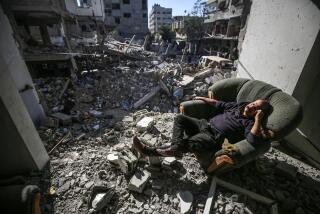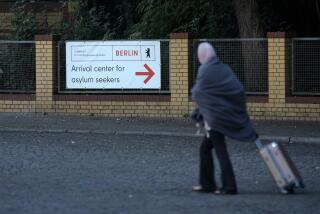New memories of Berlin
BERLIN — One thing does lead to another. Last spring, I was obsessed with cleaning my garage; a week later, I had scheduled a trip to Berlin.
As I admired my handiwork, I eyed an old cedar chest along one wall, and I realized I hadn’t looked inside since 1988. I hadn’t wanted to. After all, it was filled with mementos of my husband, Jerry, who died in 1987 when he was a reporter for the Los Angeles Times. But now I was curious; I couldn’t remember what was in it. Surely, it was long enough to brave the memories.
I spent the next two days sifting through old letters and dozens of journals, but the ones I read with fervor were from 1954 and ‘55, the years we lived in Germany, and from 1977, when we returned for a vacation. Bittersweet, yes, but also funny and always with great memories.
When Jerry graduated from college in 1953, he received his diploma and draft papers almost simultaneously. He was sent to Kaiserslautern, in then-West Germany, at that time the largest U.S. military community outside the United States, to serve in the public information office. I joined him in 1954 as a young bride. We were on our own, living on $111.60 a month.
Germany was still occupied by the Allies, and cities were still filled with rubble from wartime bombing. We were eager to travel, particularly to Berlin, but we never got there. I don’t remember why, but I suspect it was probably because we were too poor. Our out-of-town entertainment was attending beer and pretzel festivals and visiting castles.
We returned in 1977 to tour Hungary and Yugoslavia and to reunite with our Kaiserslautern hosts. But we also saw Berlin, then a city divided by a monstrous concrete wall. Jerry and I traveled by rental car from Frankfurt, going through Checkpoint Alpha into East Germany, then driving 150 miles to Checkpoint Bravo to enter West Berlin.
After reading Jerry’s journals and letters, and knowing that this year Berlin was celebrating the 20th anniversary of the fall of the wall on Nov. 9, I had another obsession -- to return and see how much had changed. So, I added Berlin to a scheduled trip to Provence, France.
I arrived by air in July and told my taxi driver, Albert, the name of my hotel, the John F. (after Kennedy). He had never heard of it but said he’d try to find it. I must have looked suspicious, because he grinned and said, “Berlin is a big city.” But he was friendly and spoke English, and because the hotel had been open only four months, I took a chance.
I’m glad I did. Albert could be a tour guide; he pointed out every major and minor site along the 20-minute drive to the hotel (yes, he found it), including Berlin’s symbol, the Brandenburg Gate, which looked like nothing I remembered. In 1977, it had appeared forlorn and neglected behind the wall in the bleak Eastern Sector. Now, it’s a tourist mecca, and I couldn’t tell where east and west once had been. We rode around the perimeter, and I spotted souvenir stands, street performers and “soldiers” dressed in military garb posing with tourists.
We drove along Unter den Linden (Under the Linden Trees), once one of the grandest streets in Berlin, dating to the mid-1600s. Most of the trees were destroyed or chopped down for firewood during World War II. New ones were planted in the late 1940s, and it looked like a splendid boulevard again.
I chose the John F. partly for its location -- three blocks from Unter den Linden, two blocks from the underground and two blocks from a bus line. It was contemporary, comfortable and a definite improvement over where we stayed in 1977 -- a fourth-floor room and a shared bath in a hotel with no elevator.
Armed with maps, brochures and transportation information, I walked two blocks to Gendarmenmarkt, a beautiful square that is home to the French Cathedral, the German Cathedral and the Konzerthaus (theater and concert hall). The buildings, which were destroyed during the war, have all been restored.
I repeatedly saw this determination to rebuild Berlin as it was (with few exceptions) by restoring buildings to their prewar condition. Another nice touch is the city’s use of faux facades on buildings awaiting restoration.
Two bus lines leave Gendarmenmarkt for most of the major attractions, although sometimes the underground proved faster. The smartest thing I did was buy a Welcome Card, good for trams, subways, buses and trolleys (for two, three or five days from $23 to $42).
But first I wanted to better acclimate myself, so I bought a ticket for a hop-on/hop-off double-decker bus tour with an English-speaking guide. It was a good idea. I got a history lesson, tidbits of trivia and a sightseeing extravaganza. And in five minutes, I realized that I was foolish to think I could see much of Berlin in only three days.
How could I? Berlin, population 3.4 million, has about 175 museums, 150 theaters, eight symphony orchestras and three opera houses.
The tour bus drove past sidewalk cafes, beer gardens, open-air restaurants, the restored Berlin Cathedral, many of the 120 embassies (almost all built since 1999, when the government moved to Berlin from Bonn) and along the Kurfurstendamm, the city’s most luxurious shopping district.
We also drove past a few sections of the remaining wall. Most of its 96-mile length vanished after the fall, when sections were sold, given away or carted off as souvenirs. There are many sections in the United States, including those at L.A.’s Loyola Marymount University and the Richard Nixon Library in Yorba Linda.
I got off the bus at Potsdamer Platz, where Jerry and I had stood on an observation platform and looked down into East Berlin and the broad expanse of empty space known as the “Death Strip,” filled with barbed wire, land mines and watchdogs.
The space remained bare until 1994, when rebuilding began. Today, the area is occupied by the $5-billion Sony Center, along with a mall, theaters, restaurants, hotels, offices and apartments. About six blocks away, still in the vicinity of the Death Strip, is the Memorial to the Murdered Jews of Europe, an open area of 2,711 concrete blocks of varying heights designed by American architect Peter Eisenman. Children ran through it as if it were a labyrinth playground.
In some areas of the city center, a double row of cobblestones marks where the wall once stood. One row starts at Potsdamer Platz and leads past a large remaining section with gaping holes made by souvenir hunters. It’s only a few blocks from here to Checkpoint Charlie, the American Sector’s border crossing between East and West Berlin.
When we went through Checkpoint Charlie to enter dismal-looking East Berlin in 1977, the Russians searched under the seats, in the trunk, under the car, even in my purse. They confiscated our copy of Newsweek on the back seat.
Today, Checkpoint Charlie is one of the city’s most popular attractions. The neighborhood is filled with tourists and scattered with souvenir stands selling reproduction Soviet army hats and military items and all sorts of gewgaws from the wall era. You can get your passport stamped for 2 euros or have your photo taken with Berliners dressed in Russian or American uniforms for 1 euro.
The Berlin Wall Museum faces Checkpoint Charlie. It highlights the worldwide struggle for human rights, as well as displays about the wall and attempted escapes.
A few underground stops away, the Berlin Wall Documentation Center describes living with the wall as it divided Bernauer Street, where people jumped out of windows in an attempt to get across. The DDR Museum, which opened in the city center alongside the Spree River in 2006, is immensely popular with Berliners, even though it is small and crowded with tourists. But it offers an interesting hands-on experience of what life was like in the Eastern Sector from home and family to fashion. It even has a legendary East German Trabant (whose 1975 version Time magazine rated as one of the 50 worst cars of all time) on display, into which visitors climb to have their pictures taken.
I would have had a fourth day in Berlin if I had flown back to Paris to catch my flight home. But I wanted to take the high-speed German ICE train instead, and it’s an all-day journey.
My last German train trip was in 1955, when Jerry and I rode a rough-riding, grimy coach destined for a wine festival in Rudesheim. We had to get off the train and take a ferry across the Rhine River because the bombed-out bridges had not yet been rebuilt.
The ICE was smooth and silent as I looked out the window at the Rhine near Cologne. And it was much more comfortable than being squished into an airline seat. I’ve resolved to return to Berlin to see what I’ve missed, and when I do, I’ll travel by train from Frankfurt.
--
--
BEGIN TEXT OF INFOBOX
Visiting Berlin
The Festival of Freedom celebration on Nov. 9 ends with an official reenactment of the toppling of the wall using specially designed 4-foot-tall dominoes arranged along the former border. They will be knocked over, and the last domino will fall at the Brandenburg Gate, where a major concert and street festival with fireworks will take place.
THE BEST WAY TO BERLIN
From LAX, Lufthansa, KLM, Air France and Continental offer connecting service (change of planes) to Berlin. Restricted round-trip fares begin at $557.
TELEPHONES
To call the numbers listed below from the U.S., dial 011 (the international dialing code), 49 (country code for Germany), 30 (the city code) and the local number.
WHERE TO STAY
Arcotel John F, 11 Werderscher Markt; 405-0460, www.arcotel.at. Reasonably priced, with doubles starting at about $122 a night.
WHERE TO EAT
Lutter & Wegner, 56 Charlottenstrasse; 202-9540, www.lutter-wegner-gendarmenmarkt.de. Entrees start at about $22.
Refugium, 5 Gendarmenmarkt; 229-1661, www.restaurant-refugium.de. A variety of set three-course meals starting at about $48.
TO LEARN MORE
Berlin tourism: www.visitberlin.de/english/berlin-infos/index.php
German rail: www.bahn.de/international/view/en/index.shtml
About the wall: www.berlin.de/mauer/index.en.html
More to Read
Sign up for The Wild
We’ll help you find the best places to hike, bike and run, as well as the perfect silent spots for meditation and yoga.
You may occasionally receive promotional content from the Los Angeles Times.






